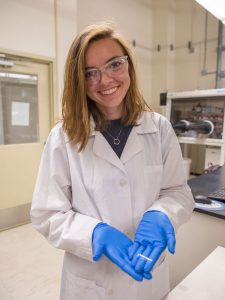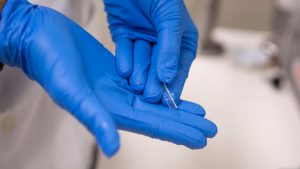Alexis Hocken
Chemical engineering
Hometown: Scottsdale, Arizona, United States
Graduation date: Spring 2021

FURI | Spring 2021
Characterizing Nanocomposites for Customizable Cartilage Replacements
The properties and characteristics of photocurable nanocomposites can be tailored to mimic those of various tissues and/or cartilage, allowing the bio-inspired synthetic material to replace them. The long-term goal of this project is to 3D print the replacements so they can be tailored to fit individual patients. Therefore, it is critical that the thermal, mechanical, and morphological properties of the nanocomposites be more acutely understood to predict the material’s behavior. In this investigation, methacrylate-functionalized silica nanoparticles were incorporated into the composite to alter its properties. The characterization of this material will give better insight into its applicability as cartilage replacements.
Mentor: Matthew Green
Featured project | Spring 2021
Alexis Hocken is a chemical engineering senior in the FURI program. She is contributing to the future of customizable cartilage replacements that are more effective and longer-lasting through the design of a new polymer nanocomposite material.
What made you want to get involved in FURI?
I wanted to get involved in FURI because it seems like a great opportunity to continue building my skill set as a researcher. The end-of-semester FURI Symposium is a great way to fine-tune presentation skills and hear perspectives from my peers that I could use in my future work.
Why did you choose the project you’re working on?
I chose the project that I am working on because I am really excited about polymer science and engineering in the context of biological systems. My project involving nanocomposites for cartilage replacements has allowed me to further dive into that passion of mine.
What has been your most memorable experience as a student researcher?
The most memorable experience has been the process of writing a manuscript that will be submitted for publication. Seeing a research project that you designed turn into such an interesting story that can hopefully impact the scientific community is beyond exciting. Furthermore, the writing process has been an incredible learning experience in itself.
How will your engineering research project impact the world?
My research project is laying the framework for creating customizable cartilage replacements. Creating a material that is specifically created for a patient with certain requirements will allow the cartilage placement to not only be more effective but also improve longevity.
How do you see this experience helping with your goals?
FURI has allowed me to build critical skill sets such as problem-solving, data analysis and public speaking. This has served as a foundation for me to become an impactful researcher in my future studies, specifically when I begin my PhD studies this fall at MIT.
What is the best advice you’ve gotten from your mentor, Associate Professor Matthew Green?
The best advice I have received from my faculty mentor has been to utilize every project as an opportunity to grow as a researcher and build your network. Many times it can be tempting to just complete the bare minimum requirements, but if you look for ways to take any project to the next level, it has the potential to lead to a pivotal step in your career.
Why should other students get involved in FURI?
I highly encourage other students to get involved in FURI. This program is set up in a way that makes it easy for those beginning their research journey to get involved. I find research to be such an exciting career path, and FURI gives you a glimpse of what a career in research could look like.


